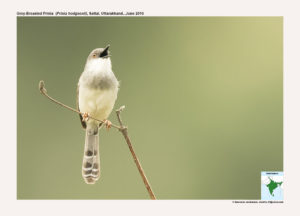Grey-breasted Prinia

Grey-breasted Prinia Prinia hodgsonii
Etymology:
- Prinia : Javanese name Prinyafor the Prinia
- Hodgsonii :Named after English diplomat Brian Houghton Hodgson (1800–1894)
Vernacular Names : Hindi: Phutki, Cachar: Dao pitti, Daotisha-pitti, Guj: Kathiawadifudki, Nanifadakfutki, Ta: Tinu-kuruvi, Kosukatai, Nunnichirai, Mal: Talikkuruvi, Sinh: Hambu-kurulla, Mar: RakhiChatichaVatvatya
Distribution in India: Resident across India
Description: Size of 10-12 cm.In Non-breeding plumage it has dusky lores, short white Supercilium; greyish olive-brown above, dark brown wing feathers edged warmer rufous-brown (impression of rufous panel on folded wing); tail dark grey-brown, blackish sub-terminal marks before narrow whitish tips on all except central feather pair (best viewed from below); throat and underparts creamy white; iris pale yellow to orange brown; bill dark horn-brown, paling at base of lower mandible; legs yellow to yellowish-flesh. In breeding plumage white line above lores disappears, leaving greyish hood, shading darker on lores and ear-coverts; usually has grey band across breast, and grey flanks; bill much blacker, also bright orange orbital ring when in breeding condition. Both the sexes are similar.
Habitat: It is found in open forest, forest edge, riverside thickets such as Lantana scrub or reed beds; also overgrown gardens and rank areas of scrub and grass at edges of cultivation; sometimes in mangrove swamps. From sea-level to 1200 m
Food Habits: It eats small invertebrates, chiefly insects and their larvae, and small spiders, also eats flower nectar. Usually singly or in pairs. Although not shy, is generally unobtrusive, keeping low in vegetation. Forages close to ground, climbing up stalks or inside bushes, gleaning insects from both leaves and ground. Often forages with mixed parties of small birds, such as various small babblers
Breeding Habits: They breed in Feb–Oct. Both sexes construct nest, taking 4–8 days, eggs laid before nest completed. The nest is a cup of grasses and fibers sewn into two or three upright leaves, which form a cone, usually within 50 cm of ground. They lay a clutch 3–4 eggs; sexes share incubation, for a period 10–11 days. The nests are parasitized by Plaintive Cuckoo.